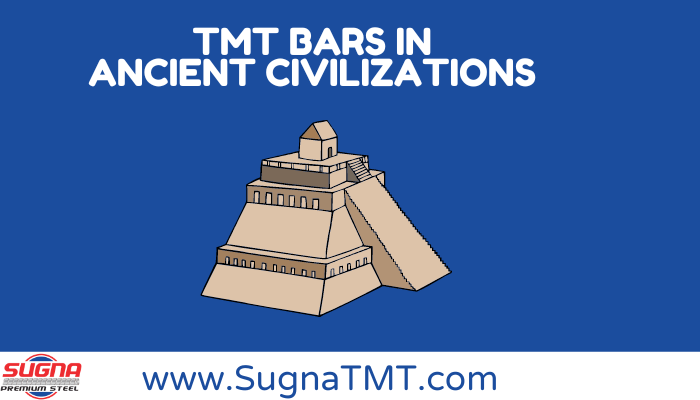The history of construction is a testament to human ingenuity and innovation. While modern techniques like the use of Thermo-Mechanically Treated (TMT) bars are prevalent today, the concept of reinforcing structures dates back to ancient civilizations. In this article, we delve into the fascinating history of TMT bars in ancient civilizations and uncover their role in the development of reinforced structures.

Early Forms of Reinforced Structures
Ancient civilizations employed various techniques to reinforce their structures and enhance their durability. From the use of natural materials like wood and stone to more advanced methods involving metal reinforcement, early builders sought to create buildings that could withstand the test of time.
Ancient Civilizations and Reinforced Structures
In Mesopotamia, one of the cradles of civilization, builders utilized materials such as mud bricks and reeds to reinforce their structures against the forces of nature. Similarly, the Romans were known for their mastery of reinforced masonry, using techniques such as the incorporation of iron clamps and dowels to strengthen their buildings.
Uncovering the History of TMT Bars
The evolution of steel production techniques played a significant role in the development of TMT bars. While modern TMT bars may seem like a recent innovation, their origins can be traced back to ancient metallurgy, where early civilizations experimented with iron and steel alloys to create stronger and more durable materials.
Case Studies of Reinforced Structures in Ancient Civilizations
Numerous examples of reinforced structures from ancient civilizations still stand today as testament to their durability and ingenuity. The Colosseum in Rome, for instance, utilized iron reinforcement to support its massive stone arches and amphitheater seating. In ancient India, reinforced concrete structures known as stupa were constructed using a combination of stone and iron reinforcement.
Impact and Legacy of Ancient Reinforced Structures
The legacy of ancient reinforced structures extends far beyond their original construction. These buildings not only showcase the technological advancements of their time but also serve as valuable lessons for modern construction practices. By studying ancient building techniques, engineers and architects can gain insights into sustainable and resilient design principles.
Challenges in Preserving Ancient Reinforced Structures
Preserving ancient reinforced structures poses unique challenges due to factors such as environmental degradation, urbanization, and lack of maintenance. Conservation efforts often require a delicate balance between preserving the original structure and implementing modern restoration techniques.
Future Research and Exploration
As technology advances and our understanding of ancient construction methods deepens, there are boundless opportunities for further research and exploration. Archaeologists, engineers, and historians continue to uncover new insights into the history of reinforced structures, shedding light on the ingenuity of ancient civilizations.
Sugna TMT: Your Partner in Construction Success
Looking for the right TMT bars for your next project? Look to Sugna TMT. With a focus on quality, reliability, and expertise, we provide the products and guidance you need to achieve success in construction. Choose Sugna TMT as your partner in building excellence.
Conclusion
In conclusion, the history of TMT bars in ancient civilizations is a testament to human creativity and innovation. From the use of simple reinforcement techniques to the development of advanced materials like modern TMT bars, ancient builders laid the foundation for the construction practices we employ today. By studying their methods and accomplishments, we gain a deeper appreciation for the enduring legacy of ancient reinforced structures.

